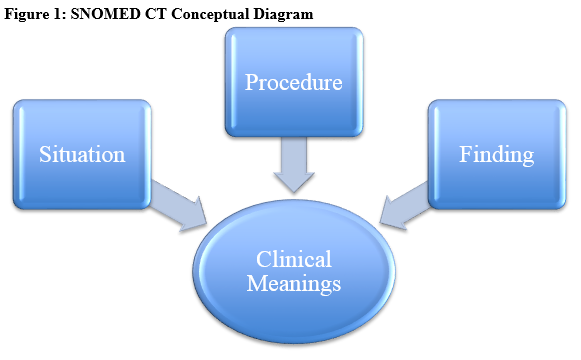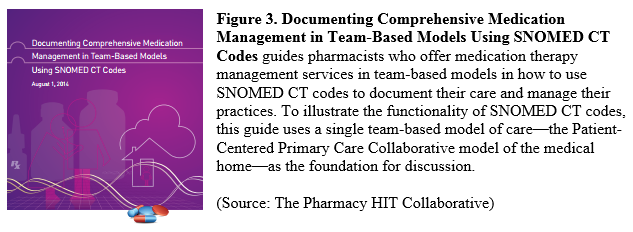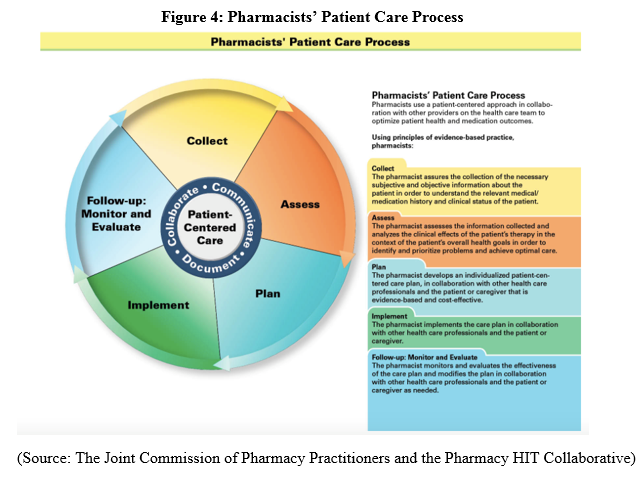Article
SNOMED CT Is Coming to Pharmacy: A Primer on Systematized Nomenclature of Medicine "Clinical Terms" Documentation (for Pharmacist and Pharmacy Services)
Author(s):
Ideally, pharmacists document clinical or progress notes where important assessments and findings are assigned specific codes to capture and measure the value of the clinical care they provide.
It all started back when physicians wrote directions to pharmacists in Latin. Latin was not widely understood by patients, making the language like a code between prescribers and pharmacists. In today’s electronic world, instead of Latin, standard terminology codes are used to ensure that medical information is communicated from one system to another. A good example of this is the use of National Drug Code (NDC) numbers and Drug Utilization Review coded messages within National Council for Prescription Drug Programs D.0 claims standards. The medical community uses International Classification of Diseases, 10th revision (ICD-10), codes for diagnosis and Current Procedural Terminology codes for medical claims.
Ideally, pharmacists document clinical or progress notes where important assessments and findings are assigned specific codes to capture and measure the value of the clinical care they provide. It is only a matter of time before system vendors program Systematized Nomenclature of Medicine—Clinical Terms (SNOMED CT) codes into their systems. Doing so should help make pharmacists’ clinical encounter documentation more standardized. Not only will this allow for more efficient and precise billing for services, but it will also enable effective communication of patients’ medication-related problems, medication history, and associated service activities with other care team members.
What Is SNOMED CT?
As the need for more coding of clinical terms specific for documentation arose in the medical profession many decades ago, the medical community turned to SNOMED CT, one of a set of standards that the United States and other countries have designated for the electronic exchange of clinical health information. SNOMED CT codes are searchable and available for free from the National Library of Medicine (NLM) through the Unified Medical Language System Metathesaurus to anyone who registers for a license. Most clinicians are familiar with using ICD-10 codes to document diagnoses within claims and progress notes. Although SNOMED CT codes exist for diagnosis, but ICD-10 is more widely adopted for this purpose.
Claims-based data typically include procedure and diagnosis codes, but they have limited clinical context for aiding in future encounters and for use within the clinical record. The SNOMED CT licensing policy clearly states that SNOMED CT can only be used for clinical documentation, not for claims. For example, if a radiologist orders a magnetic resonance imaging study and submits the claim, the payer often requests an attachment to the claim in the form of a progress note. Embedded in the progress note are the SNOMED CT codes documenting the clinical care provided by the radiologist.
Although SNOMED CT is not currently being used in the pharmacy industry, there is opportunity for pharmacists to use SNOMED CT codes to support medication therapy management (MTM) claims. Attaching progress notes to claims helps to reduce the likelihood of false claims or to justify or document that the encounter took place as described in the claim. This is what is needed to increase payer confidence in MTM billing documentation. Unlike ICD-10 codes, SNOMED CT codes—according to the license agreement—are not to be used in a claim but can be added as an attachment to the claim. Large chain pharmacies, health-system pharmacies, independent pharmacies, managed care pharmacies, and accountable care organizations all will eventually use and need to electronically document clinical encounters using SNOMED CT as a way to capture value for the services they provide.
How SNOMED CT Works
SNOMED CT is divided into concepts representing clinical meanings and organized into hierarchies of situations, procedures, and findings (Figure 1).

Each clinical term has a unique identifier represented as a number. An example of this concept is the use of NDC numbers, where the first segment represents the manufacturer, the second segment represents the product, and the third segment represents the package size. With SNOMED CT, the identification is just a number mapped to a clinical term or concept (Table). Each portion of the clinical term can have more than one description represented as a synonym that describes the same concept (eg, “medication” and “drug”), and all fall under the same code. For example, if one system uses “medication dose too low” and another system uses the term “drug dose too low,” the same SNOMED CT code would be used.
Table: Example of SNOMED CT Mapped Clinical Terms
SNOMED CT Concept
SNOMED CT Code
Referred by primary care physician
2021000124102
Patient unable to obtain medication
429611000124105
Medication dose too low
448152000
Hypertension medication review
473225006
Rheumatologic disorder education
413084000
Recommendation to increase dose
428811000124101
Medication reconciliation by pharmacist
428701000124107
Glycated hemoglobin <7%
165679005
SNOMED CT clinical concepts follow a hierarchical structure using general terms to represent the different levels in the hierarchy. For example, a “parent” term will have subterms known as “children,” and children will have subterms known as “grandchildren.” Subterms are more descriptive than their parent terms as one drills down deeper into the concept term. For example, the SNOMED CT identification for the parent concept “medication reconciliation (procedure)” is 430193006 and the identification for the child concept “medication reconciliation by pharmacist (procedure)” is 428701000124107.
Work of the Pharmacy Health Information Technology Collaborative
In 2010, 9 national pharmacy associations formed the Pharmacy Health Information Technology (HIT) Collaborative “to assure that pharmacists were integrated into the health care system to increase the quality of patient care, to advocate and educate key stakeholders regarding the meaningful use of HIT, and include pharmacists into a technology-enabled integrated health care system.”
In addition, with the help of the NLM, which manages the US SNOMED CT version, the Collaborative performed a gap analysis of over 330,000 clinical terms within the SNOMED CT international database and identified approximately 270 new MTM and pharmacy-related codes. Hepler and Strand developed the basic concepts and terms for what we now call MTM services and pharmaceutical care.1 These terms were used to identify the first set of MTM SNOMED CT codes. All these MTM codes are currently available in the SNOMED CT database under the classification “medication therapy.”
As a result, the Collaborative is the steward of MTM pharmacy-related SNOMED CT codes and, through the Collaborative’s Value Set Committee, has created a process to add and maintain a list of codes for the pharmacy industry. The Collaborative will also publish an implementation guide accompanying the pharmacy value sets to aid users in incorporating these codes into their respective HIT systems.
The Collaborative produced 2 guidance documents to help introduce pharmacists to SNOMED CT codes and educate those who provide MTM services in a team-based environment with examples of how SNOMED CT codes can be used to document patient care (Figures 2 and 3).


What Are SNOMED CT Value Sets?
A value set often includes codified concepts from established standard vocabularies or nomenclature terminologies. For example, a value set for a patient’s symptoms may include a range of problems or conditions (eg, sore throat, dizziness, cough). This value set would be different from a list of diagnoses. A value set is defined as “a list of specific values (terms and their codes) derived from single or multiple standard vocabularies used to define clinical concepts (eg, patients with diabetes, clinical visit, reportable disease) used in quality measures and to support effective health information exchange.”2
Value sets specific for MTM SNOMED CT codes, such as a defined set of drug therapy problems, help system vendors and compendium-driven databases standardize MTM clinical documentation. Having 1 specific set of codified clinical terms helps payers and government agencies collect outcome measures in a standard way. Giving pharmacists the ability to electronically capture standard codified clinical encounters within their pharmacy systems will help pharmacists participate and be paid in value-based payment models.
The Collaborative is in the process of building several MTM value sets using a list of identified MTM SNOMED CT codes. In the near future, these value sets will be available on the Collaborative’s website for public comment before publication within the NLM’s Value Set Authority Center.2
Why Is SNOMED CT Important to Pharmacy?
The Joint Commission of Pharmacy Practitioners developed steps outlining a standardized pharmacist patient care process to use as a framework for delivering patient care in any practice setting3 (Figure 4).

As pharmacists begin to follow this process, electronically documenting the steps using standard codes will become essential when communicating encounters with other health care professionals, payers, and patients. The availability of standard pharmacy-specific MTM SNOMED CT coding will give pharmacists the ability to document their actions, track medication-related outcomes, and prove—with hard data—the value of MTM services.
The use of SNOMED CT codes assists pharmacists’ standardized documentation of patient care following these patient-centered steps. According to the SNOWMED CT Starter Guide, “SNOMED CT supports the development of comprehensive high-quality clinical content in health records. It provides a standardized way to represent clinical phrases captured by the clinician and enables automatic interpretation of these. SNOMED CT is a clinically validated, semantically rich, controlled vocabulary that facilitates evolutionary growth in expressivity to meet emerging requirements.”4
When these rich clinical data are collected in a standard electronic way, the health care industry can analyze clinical care more efficiently than when using claims-based data. Codes used in claims-based data mainly capture procedures, whereas electronic clinical documents using SNOMED CT codes capture richer data. This allows for a better way to acquire clinical assessment documentation of situations, procedures, or findings. For pharmacists, this means payers will have the ability to acknowledge pharmacist-driven, value-based, medication-related outcomes for emerging payment models.
What Is Driving SNOMED CT Adoption?
One of the emerging models that is driving SNOMED CT adoption is the Centers for Medicare & Medicaid Services (CMS) Center for Medicare & Medicaid Innovation’s (CMMI) Part D Enhanced Medication Therapy Management Model.5 This 11-state, 5-region enhanced MTM pilot model features payment incentives for basic stand-alone prescription drug plans. According to the model fact sheet, “MTM programs can generate cost savings and result in improved outcomes for patients in a variety of ways.”6,7
In a November 18, 2015, CMMI response to stakeholders about quality and performance monitoring, they identified the use of SNOMED CT code collection as a means to standardize the data. CMS “will collect MTM encounter data incorporating elements such as beneficiary identifiers, dates and locations of service, provider identifiers, and coupled SNOMED codes to detail MTM-related activities and outcomes.”8 CMS is not identifying specific SNOMED CT codes for quality measures, but is instead asking prescription drug plans to identify their own innovative measures through standardized data collection to identify potential future outcomes-focused quality measures. In other words, CMS wants the prescription drug plans to be innovative and find out which outcomes really make a difference to patient care.
Other than the CMS meaningful use of EHR incentive programs, this is the first CMS program in which pharmacists have an opportunity to capture MTM outcomes-based measures using SNOMED CT. Because SNOMED CT codes are not widely known to the pharmacy community, however, there is confusion about how to implement these codes within the MTM workflow. Fortunately, SNOMED CT codes will be mapped to pharmacist-provided MTM service documentation, similar to how pharmacy-dispensing systems map NDC codes to drug products.
Connecting the Dots Through Mapping
The implementation of SNOMED CT to facilitate the interoperable exchange of health information is not a new concept. For example, for years the NLM has mapped patient-identified problems represented in SNOMED CT to ICD diagnosis codes. In today’s version, using ICD-10, this mapping is embedded in the problem list section of EHRs used by physicians and other health care providers.9 This type of mapping can be used by prescribers’ e-prescribing systems to map the patient’s problem identified in the EHR problem list to identify a medication indication for a diagnosis.
Other types of pharmacy-related mapping already exist, such as between RxNorm codes and NDC numbers for e-prescribing. Pharmacy management systems map the RxNorm codes received from the prescriber in an electronic prescription to the NDC number representing what the pharmacy will dispense. As a result, prescribers are now using RxNorm codes for prescribed medications instead of representative NDC numbers.
For MTM services, once the clinical outcome concept is identified, the clinical term can be mapped to an existing SNOMED CT code. An MTM subcontractor would typically perform this mapping on behalf of a prescription drug plan using proprietary codes to document its customers’ outcomes. These proprietary codes can be mapped easily to existing MTM SNOMED CT codes. Proprietary codes are used when standard codes are not available. There is no benefit to using a proprietary code over a standard code. Standard codes are more beneficial than proprietary codes because they can be exchanged outside closed networks and can be used to develop national measures.
As previously stated, SNOMED CT mapping is a way to link clinical terms to codes. It is a way for EHRs to standardize the capture of pertinent clinical concepts to improve data quality for clinical quality measures and facilitate the electronic exchange of clinical data in an interoperable way.
What Is SNOMED CT Implementation Going to Cost?
The cost to implement SNOMED CT is minimal compared with the cost of adopting EHR or HIT applications to capture the codes. Several studies have estimated the cost of EHR purchase and installation to range from $15,000 to $70,000 per provider. The cost for implementing the SNOMED CT codes in an organization’s current EHR or HIT system is unknown and should include the time involved to map the clinical term documentation to a code. If the EHR uses a compendium vendor (eg, First Databank, Medispan) or an MTM subcontractor (eg, Outcomes MTM, Mirixa), the process of entering codes into the system may be done automatically through the vendor, which would also cut down on cost. No additional licensing needs to be purchased in order to use SNOMED CT.10
According to the American Health Information Management Association, “It is now common for terminology developers and distributors to develop their own mappings or to extend standards development organization or government maps in what the vendor terms a ‘value add.’ EHR vendors may also develop and incorporate maps into their products.”11
Of the hundreds of thousands of SNOMED CT codes in the international database, the Pharmacy HIT Collaborative has identified about 300 terms that can currently be used to document MTM services. The question remains, however, “How do we use SNOMED CT coding to bring pharmacists’ clinical documentation into a broader role for clinical care?” Getting system vendors to adopt SNOMED CT is the first step in reaching this goal. Once pharmacists get a system vendor to program the codes behind the scenes, the computer will do all the work.
Summary
SNOMED CT is one of a set of standard terminologies the United States (due to the CMS meaningful use of EHR incentive program12) has designated for electronic health information exchange and codification of standardized clinical measures. Therefore, it is an obvious choice for pharmacists to electronically capture pharmacist-provided patient-care outcomes. SNOMED CT is the best choice because all systems will eventually use the same standard and eliminate proprietary coding. Pharmacists, payers, pharmacy chain headquarters executives, health-system pharmacy directors, independent pharmacy owners, managed care pharmacy directors, and accountable care organization executives should have a better understanding of SNOMED CT and how it affects pharmacy. It is only a matter of time before SNOMED CT use by the pharmacy industry becomes as common as using NDC numbers to identify dispensed medications.
This article is published in collaboration with the Directions in Pharmacy CE Conference program.
Shelly Spiro, RPh, FASCP, is the executive director of Pharmacy HIT Collaborative.
References
- Hepler CD, Strand LM. Opportunities and responsibilities in pharmaceutical care. Am J Hosp Pharm. 1990;47:533-543.
- Value Set Authority Center. US National Library of Medicine website. vsac.nlm.nih.gov. Updated December 17, 2015. Accessed January 18, 2016.
- Pharmacists’ patient care process. American Pharmacists Association website. pharmacist.com/sites/default/files/PatientCareProcess.pdf. Published May 29, 2014. Accessed January 18, 2016.
- Randorff Højen A, Kuropatwa R. SNOMED CT starter guide, version: 2014-12-02. International Health Terminology Standards Development Organisation website. http://snomed.org/starterguide.pdf. Published December 2014. Accessed January 18, 2016.
- Part D enhanced medication therapy management model. Centers for Medicare & Medicaid Services website. https://innovation.cms.gov/initiatives/enhancedmtm/. Updated January 5, 2016. Accessed January 18, 2016.
- Part D enhanced medication therapy management model fact sheet [news release]. Washington, DC: Centers for Medicare & Medicaid Services; September 28, 2015. www.cms.gov/Newsroom/MediaReleaseDatabase/Fact-sheets/2015-Fact-sheets-items/2015-09-28.html. Accessed January 18, 2015.
- Centers for Medicare & Medicaid Services Center for Medicare & Medicaid Innovation. Evidence supporting enhanced medication therapy management. Centers for Medicare & Medicaid Services website. https://innovation.cms.gov/Files/x/mtm-evidencebase.pdf. Accessed January 18, 2015.
- Part D enhanced medication therapy management (MTM) model: responses to stakeholder inquiries. Centers for Medicare & Medicaid Services website. https://innovation.cms.gov/Files/x/mtm-rsi.pdf. Updated November 18, 2015. Accessed January 18, 2016.
- SNOMED CT to ICD-10-CM map. US National Library of Medicine website. www.nlm.nih.gov/research/umls/mapping_projects/snomedct_to_icd10cm.html. Updated August 26, 2015. Accessed January 18, 2016.
- How much is this going to cost me? HealthIT.gov website. www.healthit.gov/providers-professionals/faqs/how-much-going-cost-me. Updated November 12, 2014. Accessed January 18, 2016.
- Hyde L, Jones L, Noreen N, Rihanek T, Scichilone R, Simmons C. Data mapping best practices. American Health Information Management Association. http://library.ahima.org/xpedio/groups/public/documents/ahima/bok1_050536.hcsp?dDocName=bok1_050536. Published 2013. Accessed January 18, 2016.
- NLM tools for EHR certification and meaningful use. National Library of Medicine website. www.nlm.nih.gov/healthit/meaningful_use.html. Accessed January 18, 2016.
Newsletter
Stay informed on drug updates, treatment guidelines, and pharmacy practice trends—subscribe to Pharmacy Times for weekly clinical insights.






